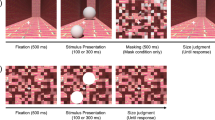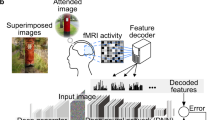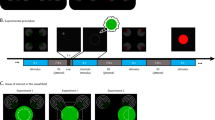Abstract
The constructive nature of perception can be demonstrated under viewing conditions that lead to vivid subjective impressions in the absence of direct input. When a low-contrast moving grating is divided by a large gap, observers report seeing a 'visual phantom' of the real grating extending through the blank gap region. Here, we report fMRI evidence showing that visual phantoms lead to enhanced activity in early visual areas that specifically represent the blank gap region. We found that neural filling-in effects occurred automatically in areas V1 and V2, regardless of where the subject attended. Moreover, when phantom-inducing gratings were paired with competing stimuli in a binocular rivalry display, subjects reported spontaneous fluctuations in conscious perception of the phantom accompanied by tightly coupled changes in early visual activity. Our results indicate that phantom visual experiences are closely linked to automatic filling-in of activity at the earliest stages of cortical processing.
This is a preview of subscription content, access via your institution
Access options
Subscribe to this journal
Receive 12 print issues and online access
$209.00 per year
only $17.42 per issue
Buy this article
- Purchase on SpringerLink
- Instant access to full article PDF
Prices may be subject to local taxes which are calculated during checkout






Similar content being viewed by others
References
Tynan, P. & Sekuler, R. Moving visual phantoms: a new contour completion effect. Science 188, 951–952 (1975).
Weisstein, N., Maguire, W. & Berbaum, K. Phantom-motion aftereffect. Science 198, 955–958 (1977).
Kastner, S., Pinsk, M.A., De Weerd, P., Desimone, R. & Ungerleider, L.G. Increased activity in human visual cortex during directed attention in the absence of visual stimulation. Neuron 22, 751–761 (1999).
Ress, D., Backus, B.T. & Heeger, D.J. Activity in primary visual cortex predicts performance in a visual detection task. Nat. Neurosci. 3, 940–945 (2000).
Ramachandran, V.S. Filling in the blind spot. Nature 356, 115 (1992).
Rauschenberger, R. & Yantis, S. Masking unveils pre-amodal completion representation in visual search. Nature 410, 369–372 (2001).
Sereno, M.I. et al. Borders of multiple visual areas in humans revealed by functional magnetic resonance imaging. Science 268, 889–893 (1995).
DeYoe, E.A. et al. Mapping striate and extrastriate visual areas in human cerebral cortex. Proc. Natl. Acad. Sci. USA 93, 2382–2386 (1996).
Engel, S.A., Glover, G.H. & Wandell, B.A. Retinotopic organization in human visual cortex and the spatial precision of functional MRI. Cereb. Cortex 7, 181–192 (1997).
Somers, D.C., Dale, A.M., Seiffert, A.E. & Tootell, R.B. Functional MRI reveals spatially specific attentional modulation in human primary visual cortex. Proc. Natl. Acad. Sci. USA 96, 1663–1668 (1999).
Shmuel, A. et al. Sustained negative BOLD, blood flow and oxygen consumption response and its coupling to the positive response in the human brain. Neuron 36, 1195–1210 (2002).
Polat, U., Mizobe, K., Pettet, M.W., Kasamatsu, T. & Norcia, A.M. Collinear stimuli regulate visual responses depending on cell's contrast threshold. Nature 391, 580–584 (1998).
Kapadia, M.K., Ito, M., Gilbert, C.D. & Westheimer, G. Improvement in visual sensitivity by changes in local context: parallel studies in human observers and in V1 of alert monkeys. Neuron 15, 843–856 (1995).
Levelt, W.J. On Binocular Rivalry (Institute of Perception Rvo-Tno, Soesterberg, The Netherlands, 1965).
Tong, F., Nakayama, K., Vaughan, J.T. & Kanwisher, N. Binocular rivalry and visual awareness in human extrastriate cortex. Neuron 21, 753–759 (1998).
Polonsky, A., Blake, R., Braun, J. & Heeger, D.J. Neuronal activity in human primary visual cortex correlates with perception during binocular rivalry. Nat. Neurosci. 3, 1153–1159 (2000).
Tong, F. & Engel, S.A. Interocular rivalry revealed in the human cortical blind-spot representation. Nature 411, 195–199 (2001).
Lee, S.H., Blake, R. & Heeger, D.J. Traveling waves of activity in primary visual cortex during binocular rivalry. Nat. Neurosci. 8, 22–23 (2005).
Lamme, V.A. Why visual attention and awareness are different. Trends Cogn. Sci. 7, 12–18 (2003).
Tong, F. Primary visual cortex and visual awareness. Nat. Rev. Neurosci. 4, 219–229 (2003).
Baars, B.J. The conscious access hypothesis: origins and recent evidence. Trends Cogn. Sci. 6, 47–52 (2002).
Rees, G., Kreiman, G. & Koch, C. Neural correlates of consciousness in humans. Nat. Rev. Neurosci. 3, 261–270 (2002).
Dennett, D.C. Consciousness Explained (Little Brown, Boston, 1991).
Ramachandran, V.S. Filling in gaps in logic: reply to Durgin et al. Perception 24, 841–845 (1995).
Durgin, F.H., Tripathy, S.P. & Levi, D.M. On the filling in of the visual blind spot: some rules of thumb. Perception 24, 827–840 (1995).
Pessoa, L., Thompson, E. & Noe, A. Finding out about filling-in: a guide to perceptual completion for visual science and the philosophy of perception. Behav. Brain Sci. 21, 723–748 (1998).
Ramachandran, V.S. & Gregory, R.L. Perceptual filling in of artificially induced scotomas in human vision. Nature 350, 699–702 (1991).
Ramachandran, V.S., Rogers-Ramachandran, D. & Stewart, M. Perceptual correlates of massive cortical reorganization. Science 258, 1159–1160 (1992).
Shams, L., Kamitani, Y. & Shimojo, S. Illusions. What you see is what you hear. Nature 408, 788 (2000).
Chen, L.M., Friedman, R.M. & Roe, A.W. Optical imaging of a tactile illusion in area 3b of the primary somatosensory cortex. Science 302, 881–885 (2003).
Paradiso, M.A. & Nakayama, K. Brightness perception and filling-in. Vision Res. 31, 1221–1236 (1991).
Kaas, J.H. et al. Reorganization of retinotopic cortical maps in adult mammals after lesions of the retina. Science 248, 229–231 (1990).
Gilbert, C.D. & Wiesel, T.N. Receptive field dynamics in adult primary visual cortex. Nature 356, 150–152 (1992).
Fiorani, M. Jr., Rosa, M.G.P., Gattass, R. & Rocha-Miranda, C.E. Dynamic surrounds of receptive fields in primate striate cortex: A physiological basis for perceptual completion? Proc. Natl. Acad. Sci. USA 89, 8547–8551 (1992).
Komatsu, H., Kinoshita, M. & Murakami, I. Neural responses in the retinotopic representation of the blind spot in the macaque V1 to stimuli for perceptual filling-in. J. Neurosci. 20, 9310–9319 (2000).
von der Heydt, R., Peterhans, E. & Baumgartner, G. Illusory contours and cortical neuron responses. Science 224, 1260–1262 (1984).
De Weerd, P., Gattass, R., Desimone, R. & Ungerleider, L.G. Responses of cells in monkey visual cortex during perceptual filling-in of an artificial scotoma. Nature 377, 731–734 (1995).
Sasaki, Y. & Watanabe, T. The primary visual cortex fills in color. Proc. Natl. Acad. Sci. USA 101, 18251–18256 (2004).
Stettler, D.D., Das, A., Bennett, J. & Gilbert, C.D. Lateral connectivity and contextual interactions in macaque primary visual cortex. Neuron 36, 739–750 (2002).
Shmuel, A. et al. Retinotopic axis specificity and selective clustering of feedback projections from V2 to V1 in the owl monkey. J. Neurosci. 25, 2117–2131 (2005).
Angelucci, A. et al. Circuits for local and global signal integration in primary visual cortex. J. Neurosci. 22, 8633–8646 (2002).
Blake, R. & Logothetis, N.K. Visual competition. Nat. Rev. Neurosci. 3, 13–21 (2002).
Gyoba, J. Disappearance of stationary visual phantoms under high luminant or equiluminant inducing gratings. Vision Res. 34, 1001–1005 (1994).
Acknowledgements
We thank Y. Kamitani, Y. Sasaki and A. Seiffert for comments on earlier versions of this manuscript, and the Center for the Study of Brain, Mind and Behavior, Princeton University, for MRI support. This work was supported by grant R01 EY14202 from the US National Institutes of Health to F.T.
Author information
Authors and Affiliations
Corresponding author
Ethics declarations
Competing interests
The authors declare no competing financial interests.
Supplementary information
Supplementary Movie 1
Demonstration of a moving visual phantom. (MOV 319 kb)
Rights and permissions
About this article
Cite this article
Meng, M., Remus, D. & Tong, F. Filling-in of visual phantoms in the human brain. Nat Neurosci 8, 1248–1254 (2005). https://doi.org/10.1038/nn1518
Received:
Accepted:
Published:
Issue Date:
DOI: https://doi.org/10.1038/nn1518
This article is cited by
-
Neural correlates of lateral modulation and perceptual filling-in in center-surround radial sinusoidal gratings: an fMRI study
Scientific Reports (2022)
-
Amodal completion and relationalism
Philosophical Studies (2022)
-
The human imagination: the cognitive neuroscience of visual mental imagery
Nature Reviews Neuroscience (2019)
-
Time-compressed preplay of anticipated events in human primary visual cortex
Nature Communications (2017)
-
The neuroimaging signal is a linear sum of neurally distinct stimulus- and task-related components
Nature Neuroscience (2012)



